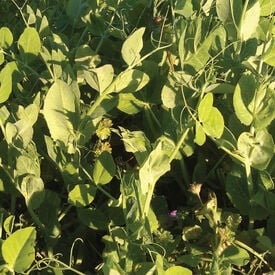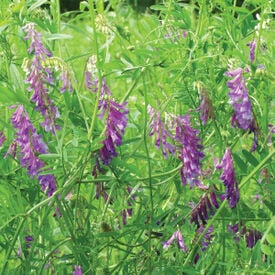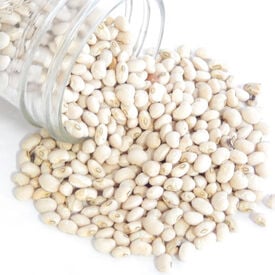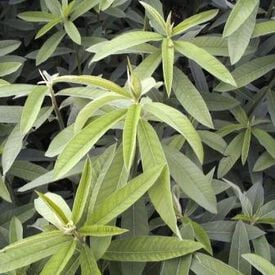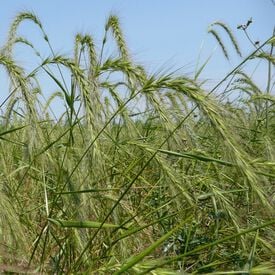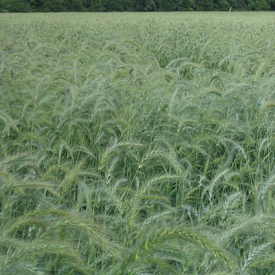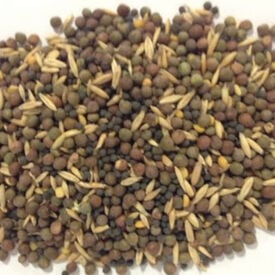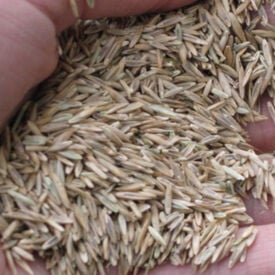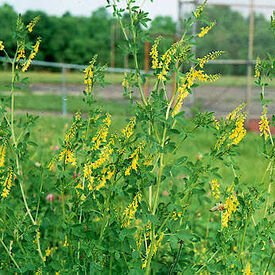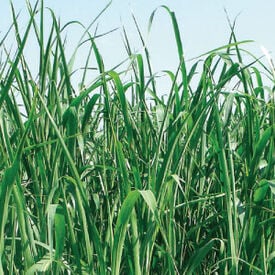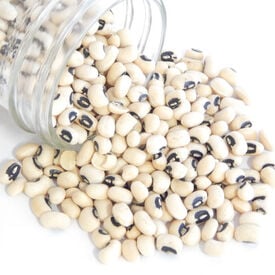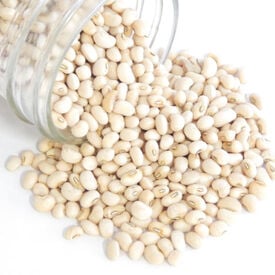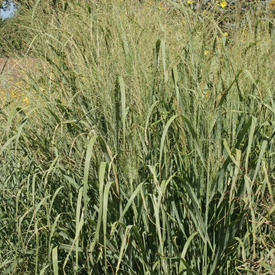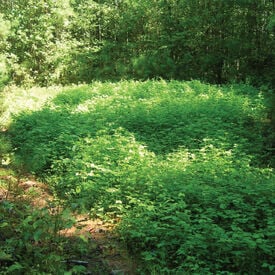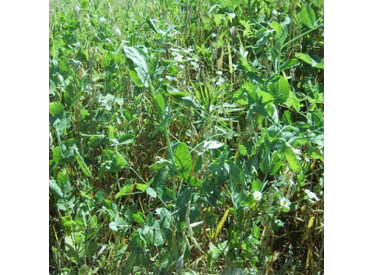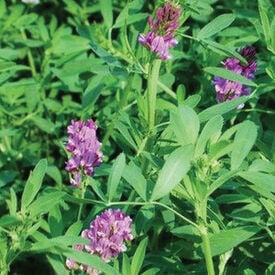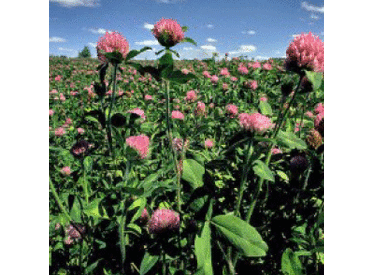The Secada Forage Pea is a relatively new forage pea that has a wide range of uses such as forage, green manure, weed suppression and more! This forage pea is highly palatable, self-climbing and with high dry matter yields. A fast growing, cool-season annual legume, the Secada Forage Pea performs very well during the fall, winter and spring in Southern states. In more northern climes, an early spring plant will give high dry matter yields of excellent forage. Uses: Chicken Forage, Deer Attractant, Forage, Green Manure, Nitrogen Fixation, No Till, Organic Matter (Biomass), Weed Suppression
When sown late summer, the Hairy Vetch spring regrowth is vigorous and nitrogen-producing, for tilling in before planting spring garden crops. You can sow with or without grain, grass or field peas! The typical nitrogen produced of this legume is 100 lbs. per acre. The Hairy Vetch has rapid growth that makes it a good weed suppressant. Uses: Bees & Beneficial Insects, Chicken Forage, Deer Attractant, Erosion Control, Forage, Green Manure, Nitrogen Fixation, No Till, Weed Suppression
The Texas Cream is a heavy yielding Southern cowpea that is great for fresh shelling. This variety is very similarly to 'Sadandy' but the cowpeas are slightly larger. These bush-type plants are prolific and thrive in hotter, Southern weather. Texas Cream is a "cream pea" type variety, they are generally used at the fresh shelling stage. Treated Seed.
The Sunn Hemp is a legume that makes an excellent cover crop as it is great for nitrogen fixation and nematode resistance in the soil. This legume is a fast-growing legume that produces significant quantities of biomass and fixes nitrogen into the soil with a short rotation of 60 days under optimum conditions. Plant the Sunn Hemp at least 8 weeks before first frost. For maximum benefit terminate crop at first flowering, prior to developing fibrous, hard-to-manage stalks. This legume is tolerant of dry conditions. Avg. 15,000 seeds/lb. Uses: Compaction Control, Erosion Control, Green Manure, Nitrogen Fixation, Organic Matter (Biomass), Weed Suppression
The Mandan Wildrye Grass is a fast growing, cool-season, perennial bunch-grass that is a great choice for erosion control. It can be planted early or late fall, but for best results, Mandan Wildrye should be planted in the spring. This hardy grass performs well on most soil types. The Mandan Wildrye produces and brown seed head and can grow up to 4 feet! Uses: Erosion Control, Forage, Green Manure, Nitrogen Scavenger, No Till, Organic Matter (Biomass), Weed suppression
The Canada Wildrye is a cool-season bunchgrass grain variety that can be found throughout Canada and the U.S. except in the southeastern states. It is typically found in prairies, open woods, fields and disturbed sites. This grain tends to be short-lived but provides quick stabilization for erosion control seedings, and it makes a good, early successional component of prairie mixtures. The Canada Wildrye provides quality forage for livestock and wildlife.
A multipurpose cover crop blend that is sowed in spring! A cover crop blend is great for nitrogen fixation, adding organic matter and weed suppression. This mix will quickly improve soil to maximize the benefits of cover crops for your garden. Should be inoculated for best results. (60% Field Pea, 25% Oats, 15% Hairy Vetch) Seed Coverage: - 5 lbs covers 2,000-4,000 sqaure feet - 100 lbs covers 1-2 acres Uses: Green Manure, Nitrogen Fixation, No Till, Organic Matter (Biomass), Weed Suppression
The Frontier Grazer Rye is a grain that makes a great cover crop to prevent erosion and build up organic matter in the soil! Plant this variety early to late fall; in mild climates fall through early spring. The best choice for fast, cool-season germination. The Frontier Grazer Rye captures soil nutrients in the fall to release in spring when worked into the soil. Uses: Erosion Control, Green Manure, Nitrogen Scavenger, No Till, Organic Matter (Biomass), Weed Suppression<
The Sweet Clover is a legume that is exceptional for not only attracting honey bees to the garden, but also creating green manure! This clover can grow nearly anywhere under most conditions. The Sweet Clover is our favorite clover because it is more versatile than other clovers at nitrogen fixating, erosion control and attracting beneficial insects. This variety is slow to establish the first year but comes on fast the following year and can produce up to 170 lb. of nitrogen per acre. The Sweet Clover comes OMRI Pre-inoculated. Uses: Bees & Beneficial Insects, Chicken Forage, Compaction Control, Deer Attractant, Erosion Control, Forage, Green Manure, Nitrogen Fixation, No Till, Weed Suppression
The Piper Sudangrass is a great catch crop for excess nitrogen that produces heavy amounts of organic matter and suppresses weeds. This grass grows quickly at heights up to 7 feet. The Piper Sudangrass is great for livestock forage, but should be grazed only when mature and never after a frost as it turns toxic. Uses: Erosion Control, Green Manure, Nitrogen Scavenger, No Till, Organic Matter (Biomass), Weed Suppression
The California Blackeye #46 is similar to California Blackeye #5, but with smaller seeds. Bred by the UCLA and released in 1987. California Blackeye #46 plants are more erect than California Blackeye #5. The seeds are a typical blackeye type of Southern peas with cream-colored seed coats and black pigments around the eyes. Heavy yielder. If using for Nitrogen fixation we highly recommend using a cowpea inoculant. Try with cowpea inoculant for maximum Nitrogen fixation.
The Sadandy cowpea is a heavy yielding Southern pea great for fresh shelling. The Sadandy variety is very similarly to 'Texas Cream' but the peas are slightly smaller. These bush-type plants are prolific and thrive in hotter, Southern weather. The Sadandy is a "cream pea" type variety, they are generally used at the fresh shelling stage. If you are using for Nitrogen fixation we highly recommend using a cowpea inoculant.
Switchgrass is a rhizomatous, warm-season bunchgrass that is native throughout most of the U.S. It is a major component of the Tallgrass Prairie ecosystem. Alamo originates from Live Oak County, Texas. It is late maturing and was developed as a renewable biofuel resource for the southern U.S. Recommended for pasture mixes, erosion control and soil stabilization. It also provides good nesting habitat, cover and food for many different types of wildlife.
Phenomenal cowpeas are a remarkable variety known for their impressive yield and versatility. These cowpeas produce robust, productive plants that are well-suited to a variety of growing conditions, making them a favorite among gardeners and farmers. Characterized by their large, green pods and high nutritional value, Phenomenal cowpeas offer a rich source of protein, fiber, and essential vitamins. The plants typically reach about 2 to 3 feet in height and can be grown both in garden beds and containers. They are valued for their resilience in hot and dry climates, which makes them particularly well-adapted to regions with challenging weather conditions. With a maturity period of around 70 to 80 days, Phenomenal cowpeas provide a generous harvest of flavorful, tender beans that can be enjoyed fresh, dried, or cooked in a variety of dishes. Their adaptability and high productivity make them a standout choice for both home gardeners and commercial growers.
All of the seeds below are very good at attracting deer to your property! Buckwheat - Improves top soil and an effective choke weed! Plant late spring to early summer. Establishes quickly. Matures in 60 days. Accumulates phosphorus and and potassium for following crops. Frost sensitive. All below packages come in 1lb. bags. Crimson Clover - Winter annual protects and improves soil! Plant fall or early spring. A good nitrogen fixer (70-150 lbs per acre per year). Showy crimson blooms in late spring are an excellent source of nectar for bees. Inter-seeds well with grass. Austrian Winter Pea - A great cool season legume for cover crops, wildlife and winter grazing! Austrian winter pea, sometimes called "black pea" and "field pea" is a cool-season, annual legume with good, nitrogen-fixing capabilities. Austrian winter pea is a low-growing, viny legume which has been shown to fix over 200 pounds of nitrogen per acre per year. Peas - Grow regular old peas in your deer food plot. One of the most preferred vegetables for deer. Oats - Oats will kill off winter weeds and hold soil with a mat of vegetation! A high yielding oat that can produce over 100 bushels per acre. Plant anytime of the year. Deer will graze oats all year round. Barkant Forage Turnip - Great forage crop that provides high energy feed! Barkant turnips are an improved, early maturing, diploid turnip wtih a large purple tankard shaped bulb. Barkant turnips have a high leaf to stem ratio and and provide very high contentrations of protein, sugar content and leaf yields. Barkant Turnips are ideally suited for wildlife. Dwarf Essex Rape - A cabbage related plant that is a perfect grazer! Dwarf Essex Rape is a perfect grazer plant that will persist well after the first frost. Ready to pasture 6-8 weeks after sowing. Hairy Vetch - Sow with or without grain, grass or field peas! When sown late summer, grows fast and will attract wildlife. Hairy Vetch has rapid growth that makes it a good weed suppressant.
The Packer Forage Pea, or Canadian field pea, is a cool-season legume that is used for cover crops, wildlife and winter grazing! This annual legume has good nitrogen-fixing capabilities. The Packer Forage Pea is a low-growing, viny legume which has been shown to fix over 200 pounds of nitrogen per acre per year. Uses: Chicken Forage, Deer Attractant, Forage, Green Manure, Nitrogen Fixation, No Till, Organic Matter (Biomass), Weed Suppression
The Common Alfalfa is a somewhat winter hardy perennial legume, but it grows more quickly than other regular alfalfa varieties. As an annual green manure, this cool-season "Summer" alfalfa can produce up to 10 tons of organic matter per acre. Its long taproots break up compacted soil and bring up subsurface minerals. High nitrogen fixation and great bee forage. Alfalfa is basically good at everything, as it great for nitrogen fixation and bee forage! Just look at all it's uses below! Alfalfa (Medicago sativa L.): Cool season, broadleaf, Perennial, Legume (N-fixation), Upright plant growth, Crude protein: hay or silage 14-22% Uses: Bees & Beneficial Insects, Chicken Forage, Compaction Control, Deer Attractant, Erosion Control, Forage, Green Manure, Nitrogen Fixation, Nitrogen Scavenger, No Till, Organic Matter (Biomass), Weed Suppression
The Mammoth Red Clover is a large, fast growing clover that is an ideal grazing crop and can be sowed in spring, summer or fall! Mammoth Red is a popular biennial clover used for Nitrogen addition and hay crops. This red clover may be the best choice for frost seeding; it is extremely cold hardy and does well in most soils and growing conditions. The Mammoth Red Clover will fix up to 70-110 lbs. nitrogen per acre. This variety's long tap roots loosen soils and mine phosphorus and other nutrients from deep in the soil. Uses: Bees & Beneficial Insects, Chicken Forage, Compaction Control, Deer Attractant, Erosion Control, Forage, Green Manure, Nitrogen Fixation, No Till, Weed Suppression
